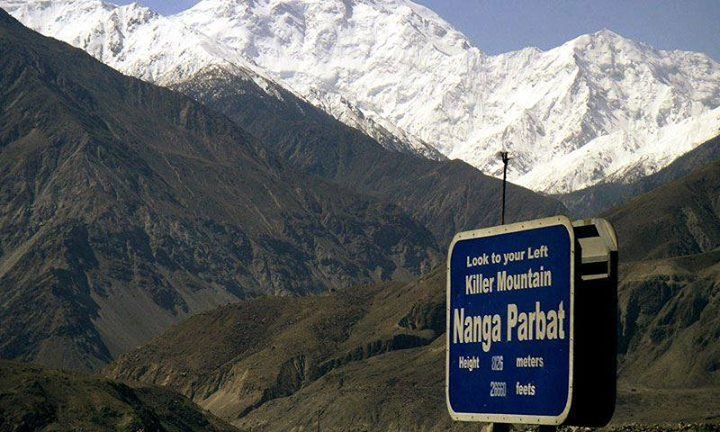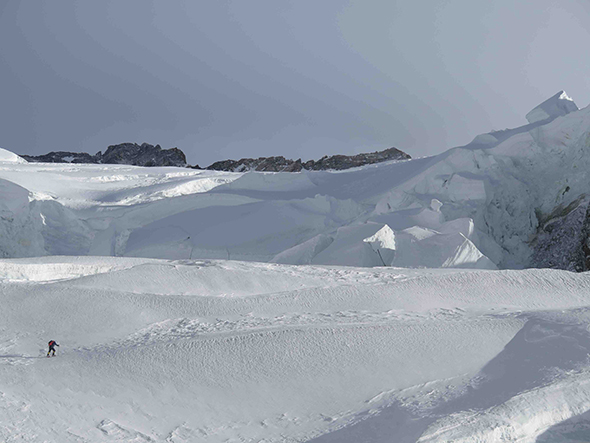Northern Pakistan is quite popular among adventure tourists around the world. Gilgit-Baltistan is settled between the western tail of Karakoram Range, the Hindu Kush mountains and the Himalayas. The region has world’s 18 highest peaks out of 50, including the second highest, K2 (8.611 meters) and the ninth highest, Nanga Parbat (8,125 meters). Mountaineers are attracted to North of Pakistan because of the challenging terrain of the mountains.
Nanga Parbat got the gruesome nickname, Killer Mountain, after the deaths of thirty mountaineers who tried to climb it before it was successfully conquered in 1953 by Hermann Buhl. For 30 years mountaineers made futile attempts to scale the peak in the months of winter.

How to get there?
Nanga Parbat has a ridge which is a combination rock and ice — a mountaineer’s worst nightmare. The mountain has three faces, all of which can be used to scale the mountain. However, all three of them have their own challenges.
- The Rupal Face is located at the south side of the mountain. It is considered as the world’s highest face with a height of 4,600 m above its base. To reach Rupal base, mountaineers start their journey from Gilgit or Karakoram Highway to Tarashing. From Tarashing, it is another two days jeep ride to the Rupal base.
- Raikot is towards the northern side of the mountain. To make a journey to Raikot, mountaineers travel the Karakoram Highway till Raikot bridge where they shift to local jeeps to continue the journey to Tato Valley in the breathtaking Fairy Meadows. The base camp is just 10 km (6.21 mi) from the Fairy Meadows.
- Diamir is the furthest away as it takes the longest to reach.
These northern areas can be easily accessed through the capital city, Islamabad. From there you have a number of options to plan your trip. If you mean strictly business then you can start of your journey as soon as you feel like it. Generally, there are various tour operators who have designed itineraries in a way that will prove to be most time effective. The added bonus is that they will know their way around the area. However, if you want to travel solo, worry not! The people of the region are extremely helpful and friendly. You may face language barrier in the north because not many people speak English fluently.
You can take the following route:
Islamabad-> Chilas -> Gilgit -> Tarashing -> Bizhin -> Shaigiri Base Camp -> Mazino Base Camp-> Mazino High Camp -> Loiba -> Kachal -> Diamir Base Camp
It should not take you more than a week to take you to Diamir Base Camp to Islamabad.
The cost of reaching there depends on the method you adopt. If you are going with a tour company it should not cost you more than $2,500. Do keep in mind this cost does not include international travel fare. It will take you to the base camp and back to Islamabad. Generally the cost will include the following:
- Four-star hotel stay
- Visa processing fee
- Transportation to the base camp and back
- Breakfast, Lunch and Dinner
- Camping/climbing equipment
- Fresh cooked meals on the trek
- Security

The First Successful Winter Ascent
On February, 26, 2016, three of the four persistent mountaineers were successful to reach the summit. Climbers included Ali Sadpara from Pakistan, Simone Moro from Italy and Alex Txikon from Spain. The fourth climber, Tamara Lunger, had to stop the ascent couple of meters beneath the summit.
At least four teams consisting of international mountaineers decided to scale the peak at the start of the year. Unfortunately not all of them got the chance to scale the mountain.
- Adam Bielecki, a renown Polish climber, was injured while fixing the ropes and he was forced to return.
- Extreme weather conditions drove Tomek and Elisabeth away after waiting for three days at Camp 3.
- A team member of Alex Txikon, Daniele Nardi, also called it off and returned after a disagreement with other team members.
Simone and Tamara, on the other hand, stayed back and waited patiently for the weather to calm down.Shortly after the weather cleared the duo picked their climbing gear including tools, which can be as sharp as a Japanese Hocho Hamono knife, which have been commonly used to climb mountains, for example; to thaw snow with. Initially, they had wanted to take up the Messner-2000 route but after some discussions and mutual understanding they decided to take the more known Kinshofer route. They were joined by Alex on that route. Some credibility issues arose initially because it was reported that the GPS tracker the foursome were using stopped providing real time location just meters before the summit.
The mountaineers who conquered the Killer Mountain in the winter

All four mountaineers are extremely well accomplished. Climbing mountains is not just a hobby for them- it is a way of life. Here are some facts about each individual:
– Muhammad Ali Sadpara belongs to Sadpara village, Sakardu, Pakistan. He started off as a low altitude porter in 2000 to earn a living. However, in 2004 he joined as a high altitude porter for a K2 expedition and realized how much he enjoyed it. His first eight-thousand peaks was Gasherbrum II in 2006. He has climbed Nanga Parbat twice (2008 and 2009).
– Simone Moro is an Italian alpinist. He is the only climber to have scaled four 8000 meter peaks in the winter season. The peaks include Shisha Pangma (8,027 m), Makalu (8,463 m), Gasherbrum II, Nanga Parbat.
– Alex Txikson was inspired by his brother to mountaineering when he was only three years old. He was only 21 years old when he first reached an 8000m peak- Broad Peak (8,051m).
– Tamara Lunger is an Italian mountaineering who started climbing mountains at a very young age. Her first high altitude peak was Island Peak (6189 m) in 2009. She successfully climbed K2, without oxygen, in 2014.

Francis Tapon is half Chilean and half French and he was born and raised in San Francisco, California. He’s been to over 80 countries, but he keeps coming back to this magical city because he loves earthquakes.
He spoke Spanish at home, French at school, and English everywhere else. He can get by in Portuguese and Italian, barely survive in Russian and Slovenian, and speak a few other languages.
Francis has an MBA from Harvard Business School and co-founded a successful Silicon Valley company that did robotic vision. He left his technology life to walk across America four times. He has thru-hiked the Appalachian Trail and the Pacific Crest Trail, and in 2007, became the first to do a round-trip on the Continental Divide Trail. In 2009, he was one of the finalists for the California Outdoors Hall of Fame, which “features nominees who are world-renowned for their skills and who have helped inspire thousands of others to take part in the great outdoors.”
Francis has written a couple of travel books including The Hidden Europe: What Eastern Europeans Can Teach Us and Hike Your Own Hike: 7 Life Lessons from Backpacking Across America. He also produced a 77-minute video about his CDT Yo-Yo.








